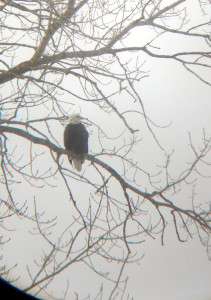By David Fleet
Editor
Brandon Twp.-Jeff Ross has a new neighbor.
For the past three years, Ross who lives near Bald Eagle Lake, has recorded the sightings of bald eagles frequenting the area. “I drive to Minnesota each year for my job,” said Ross. “When I do there’s often a bald eagle or two along the road or in trees when I’m driving. It’s really nice to have one in my front yard now.”
each year for my job,” said Ross. “When I do there’s often a bald eagle or two along the road or in trees when I’m driving. It’s really nice to have one in my front yard now.”
Ross witnessed an eagle on the ice near an abandoned fishing hole, perhaps cleaning up a few local anglers leftovers.
“It nice to see the number of eagles locally growing,” he said.
Ross should be seeing more of the majestic birds.
According to the Michigan Audubon Society there were at one point fewer than 40 pairs of nesting eagles in Michigan. Nowadays, it’s more than 800.
Jonathan Schechter is a Nature Education Writer for Oakland County government said the sighting helps confirm how our local lake inherited its name.
“The hundreds of glacially created lakes and major rivers of our county offer a four-season buffet for these majestic raptors that fish with their feet,” said Schechter. “What some people do not realize is that number of eagles seen in our area, and across Southeast Michigan, actually increases in winter. It’s all about food and fish are a mainstay of the bald eagle diet. When the northern waters of our state are iced over, the open sections of our rivers and lakes are attractive to eagles and serve as “all you can eat” buffets.”
“As for the eagle witnessed feeding at that ice fishing hole, I suspect there was a dead fish floating in the hole, or on the ice next to it, since their finely honed fishing method of soaring above and swooping down to seize a fish with their sharp outstretched talons would have been difficult to manage at an ice fishing hole,” he said. “I’m going to guess the eagle landed on the ice and walked over for its free for the taking fish dinner.”
Eagles are opportunist and rather tolerant of human activity— except at a nesting sight.
“In addition to fish, they will also take ducks and small mammals such as rabbits and muskrats and they scavenge for carrion,” he said. Schechter said that two springs ago he watched an eagle feeding on a dead deer in a meadow above Buhl Lake at Addison Oaks County Park as Turkey Vultures circled above that raptor-attracting smorgasbord.
“It’s all about adapting to opportunity and what nature or human behavior offers,” he added.
Brandon Township is just one of the areas eagles have been reported, added Schechter. Eagles are noted frequently in Kensington Metropark, and late last fall one was perched on a tree branch at Traux Lake and the very next day witnessed near Algoe Lake at the Ortonville State Recreation Area. The fact is that under State and Federal Protection, and the end of DDT use, the population of this once endangered species has soared across Michigan.
